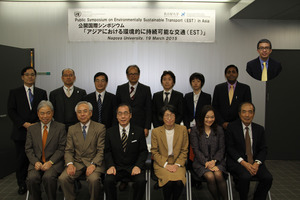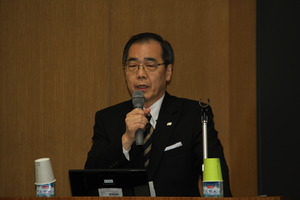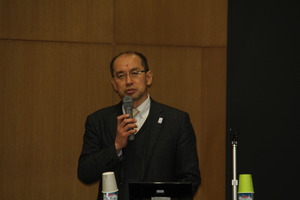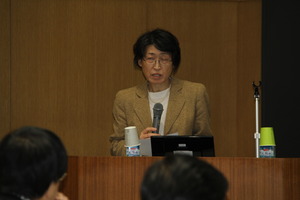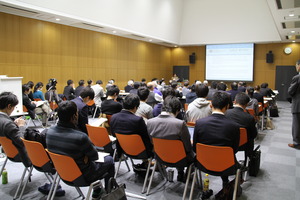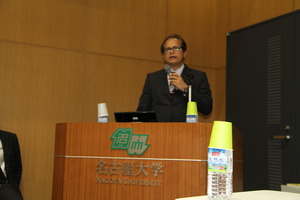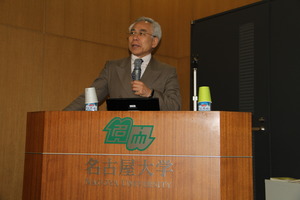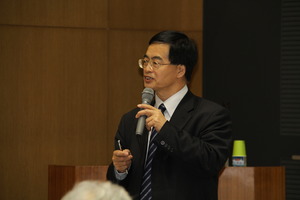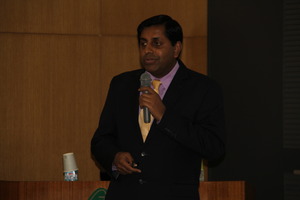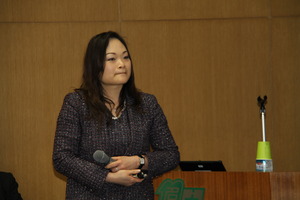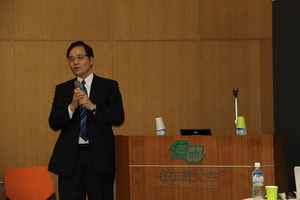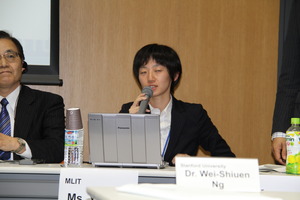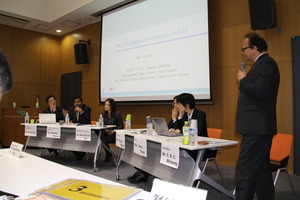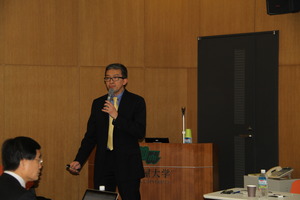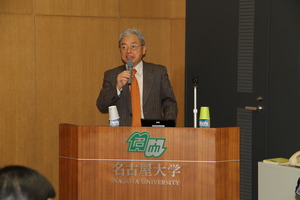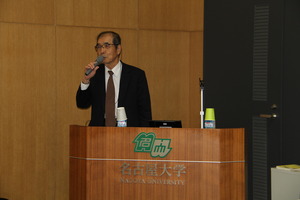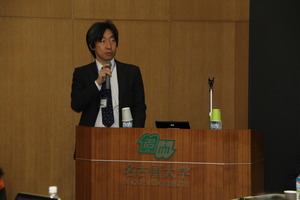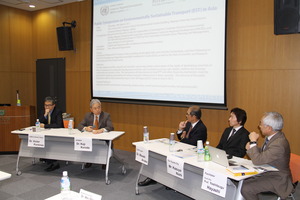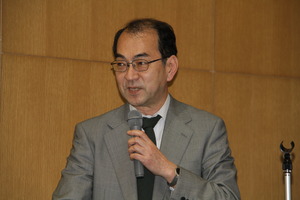Home![]() Announcements
Announcements![]() Event
Event![]() "Public Symposium on Environmentally Sustainable Transport (EST) in Asia"
"Public Symposium on Environmentally Sustainable Transport (EST) in Asia"
Announcements
2015-03-19 "Public Symposium on Environmentally Sustainable Transport (EST) in Asia"
Date:
Thursday, 19th March 2015
Venue:
The Lecture Hall, Graduate School of Environmental Studies Building, Nagoya University (Chikusa, Nagoya, Japan)
Co-organizers:
Research and Education Center for Sustainable Co-Development, Graduate School of Environmental Studies, Nagoya University (NU-SusCoDe); and United Nations Centre for Regional Development (UNCRD); and the 16th International Seminar in FY2014, the Committee of Infrastructure Planning, Japan Society of Civil Engineers (JSCE-CIP)
Theme:
Outcomes of Regional EST Forums in Asia, including the Bangkok, Bali, and Colombo Declarations, and their Relevance in Post-2015 Development Agenda/Sustainable Development Goals (SDGs), as well as the Role of Scientific and Research Community and the Private Sector
Objective:
To make Japanese public, research and scientific community, private sector aware of the needs of developing countries of Asia in transport and sustainable development and their role in achieving a smart, safe, livable, resilient and inclusive community and society in Asia. The Symposium will also discuss on how PPP and other financing mechanism could be promoted in realizing sustainable and resilient transport infrastructure in Asian countries. The outcome of the public Symposium will provide substantive input to the 9th Regional EST Forum in Asia in 2015.
Summary of Presentations and Discussions:
Opening Remarks
At first, Prof. Seiichi Matsuo, Nagoya University President-Elect, extended his gratitude and welcome to the panelists and participants coming from inside and outside Japan. He introduced that Nagoya University emphasizes not only basic research represented by the Nobel Prize winners and education at graduate and postgraduate schools but also social contribution activities in Japan and Asia. As parts of them, the university has cooperated with the United Nations Centre for Regional Development (UNCRD), which is one of the co-organizer of the symposium, and established Research and Education Center for Sustainable Co-Development (SusCoDe), another co-organizer of the symposium, under the Graduate School of Environmental Studies for taking the role of social cooperation on April, 2014. He expressed his expectation that the discussion on what the Environmentally Sustainable Transport (EST) is would be deepened through the symposium.
Secondly, on behalf of Mr. Soichiro Seki, the Vice-Minister for Global Environment at the Ministry of the Environment of Japan, Mr. Yoshikazu Ikeda, the Director General of Chubu Regional Environmental Office, read a message. It is introduced that the Regional EST Forum in Asia was launched jointly by the Ministry of the Environment of Japan and UNCRD in 2005, as a platform for policy dialogs among the high-level government representatives from the Ministries related to the EST in Asian countries and the EST experts, in order to realize the EST in Asian regions. In addition, he explained the intention for sharing the environmental policies and technologies of Japan and the knowledge for achieving resilient transport after the Great East Japan Earthquake.
Lastly, Ms. Chikako Takase, Director of the UNCRD made opening remarks as one of the co-organizers of the symposium. She introduced the outcome of the 8th Regional EST Forum held in Colombo, Sri Lanka in 2014. She also explained that the two topics, one was resilient transport against climate change and disasters and the other was financing mechanism for transport infrastructure development and maintenance, are to be discussed in the symposium and the outcome would be the suggestion from Japan for the 9th Regional EST Forum planned to be held in Katmandu, Nepal in 2015. Furthermore, she pointed out the importance to consider who, where and how for solving the problems, as well as to specify and share the good experiences in the thematic areas for the promotion of the EST policy.
Outcomes of the Regional EST Forums in Asia
Mr. Choudhury Rudra Charan Mohanty, Environment Programme Coordinator in the UNCRD, reported about the "Outcomes of the Regional EST Forums in Asia - Moving from Aichi to Post-2015 Development Era" overviewing the sequences and outcomes of the Regional EST Forums in Asia originally started from Aichi Statement in 2005. It was explained that in the past Forums, the significance of the EST policies integrated with regard to the twelve aspects has been recognized, and three strategies of avid-shift-improve have been developed and adopted. He also emphasized that integration of transports among regions and inside a region was the point urged for the EST in "The Future We Want" -the outcome of the United Nations Conference on Sustainable Development (Rio+20) held in Rio de Janeiro, Brazil in 2012. It is introduced that twenty-one countries agreed with to establish more sustainable, resilient and low-carbon (energy-saving and no greenhouse gases emissions) transport system in Colombo Declaration at 8th Regional EST Forum in Asia, 2014. Moreover, he explained that the EST is included in the Goal 11 "make cities and human settlements inclusive, safe, resilient and sustainable" in the seventeen goals called Sustainable Development Goals (SDGs) which are currently under discussion in the United Nations.
<Please click here for seeing his presentation slides (PDF file)>
Invited Lecture - Beyond Bangkok 2020 Declaration
Prof. Yoshitsugu Hayashi, Director of NU-SusCoDe, one of the symposium co-organizer, gave an invited lecture titled "Beyond Bangkok 2020 Declaration". He focused on the integrated tools for the EST as the important points which had not been considered in the former Regional EST Forums in Asia, from the viewpoint of researchers. Specifically, four points are explained: 1) low-carbonization of urban transport systems, suburbanization and policy on utilization of automobiles, compact cities, and so on, 2) analysis methods on sustainability (i.e., three strategies of avoid, shift and improve and four methods of technological, legal, information and economic incentives), 3) land-use planning with distribution of industries and population and 4) concept organization, analysis and proposal on sustainability and resilience. As an application example, the research on the estimation of transport system in Bangkok in 2050 was introduced and which showed that if the supply for railway infrastructure increases, total travel demand decreases since travel demand by automobiles decreases even though that by railways increases, and consequently it may be possible to improve the Quality of Life (QoL) while reducing the investment and greenhouse gases emissions. Besides, the issue in Beijing was presented, which was the fact that industrial factories generating much exhaust gas were relocated to Shijiazhuang with more than 300-km distant, however after that the total amount of exhaust gas increased owing to the increase of the freight traffic demand for distributing the products made in the factories to the urban areas in Beijing.
<Please click here for seeing his presentation slides (PDF file)>
Panel Discussions
Session 1: Integrated EST Policy and Resilience
In Session 1, facilitated by Mr Mohantey of the UNCRD, five panelists made brief presentations, followed by discussions on integrated EST policy and resilience.
Dr. Huapu Lu, Professor and Director of Institute of Transportation Engineering, Tsinghua University, China, reported the trend of EST policy in China in his presentation titled "Toward EST in China." He introduced smooth transport project utilizing index-based evaluation, public transportation project, low carbon experimental city, and Eco-City/Low-Carbon-City program. He also mentioned the cases of bicycle utilization promotion and bus rapid transit (BRT), as well as reduction of traffic numbers, diversification and sharing of transportation alternatives, and effective use of information and communication technology (ICT), along with the EST strategy of Avoid-Shift-Improve.
Dr. Ashish Verma, Assistant Professor, Indian Institute of Science, delivered a presentation on "EST and Resilience in Emerging Countries." He highlighted the characteristics of India in comparison with Brazil, Russia and China, such as shorter road length per population (though total length is long) and more pedestrian accidents. He also claimed that the National Disaster Management Authority in India should include transportation sector in its mandate in terms of resilience of transportation service to deal with natural disaster such as urban flooding. <presentation slides>
Dr. Wei-Shiuen Ng, Research Fellow, Stanford University Precourt Energy Efficiency Center in the US, explained the issues of fuel, technology, user behavior, and urban planning in terms of "Low Carbon City and Transport Policy in Asia." She introduced the examples of BRT, smart parking that provides services based on the varying demand, and experimental off-peak community utilizing ICT. <presentation slides>
Ms. Yoko Tsuji, Environmental Policy Division, Ministry of Land, Infrastructure, Transport and Tourism (MLIT), Japan, introduced to "Japanese EST Policy." Main points included EST model project, public transportation promotion, environmentally friendly vehicle promotion (by standards and tax holiday; major EST policy in Japan), smooth traffic secured by effective transportation infrastructure network development, and award/training. She proposed 1) transportation system driven by renewable energy and 2) transportation system that are capable to deal with natural disaster such as earthquake, as possible show cases of integrated EST policy and resilience.
Mr. Toshio Otake, Corporate Officer, Deputy Director General, and General Manager, Technology Research and Development Department, Central Japan Railway Company (JR Central), reported on "Evolution of the Tokaido Shinkansen for 50 Years and the Chuo Shinkansen using the Superconducting Magnetic Levitation Railway (SCMAGLEV)." He explained that JR Central has made continuous efforts to improve safety and efficiency of Tokaido Shinkansen - a bullet train running between Tokyo and Osaka in Japan, 50 years old in 2014 - by means of improving car design (air friction and speed), operation excellence with regard to running in the curve (speed and safety), and electric power regeneration, as well as improvements to manage delay and accidents associated with snow and other hindering factors. These efforts brought the achievement of 0.6 minutes of delay in operation on average, and no fatal accidents during its operation. Moreover, he introduced that the construction of Chuo Shinkansen - alternative trunk railroad between Tokyo and Nagoya (and Osaka) mostly beneath the mountains in central Japan - whose research and development began in 1997 was approved in 2014, and that it aimed to improve service, transportation capacity and the resilience of the trunk rail transportation system between Tokyo and Osaka. <presentation slides>
The panelists then discussed and pointed out the following things: 1) more effective land use planning and transportation policy by means of policy integration, 2) adoption of more appropriate technology by late comers (leap-flogging), 3) utilization of price signal, 4) improvement of network connectivity both for interregional and intra-regional transportation, 5) utilization of renewable energy for EST, 6) resilience improvement by EST policy, and 7) appropriate collaborative mechanisms between researchers and policy makers/administrators/governmental staffs towards formulation of integrated seamless policies and execution of science-based policies.
Session 2: Public-Private-Partnerships (PPPs) - Strategic Finance and Investment for EST
In Session 2, facilitated by Prof Hayshi of NU-SusCoDe, four panelists made brief presentations, followed by discussions on PPPs and strategic finance and investment for EST.
Dr. Victor Pontines, Research Fellow, Asian Development Bank (ADB) Institute Tokyo, delivered a short lecture on "Sustainable Transportation Infrastructure and PPPs," explaining financial demands of transportation infrastructure in Asia and globally, trends of PPPs in Asia emerging and developing countries, project finance and institutional tools, and conditions that enable PPPs. He introduced the estimated that around 45% of financing for transport infrastructure in Asia comes from sovereign wealth funds of China, Brazil, India, Russia and Singapore, around 25% does from pension funds in Japan and elsewhere, and around 10% does from private asset management companies. He stressed the need of adequate legal and regulatory development and of financial support such as governmental credit provision, differentiated depending on project characteristics. <presentation slides>
Mr. Koji Kuroda, President, Japan Expressway International (JEXWAY) explained "Strategic Finance and Investment of JEXWAY": Road transport in 21st century will be completely different from what we have now; Third revolution is occurring in terms of road transport, i.e., transportation for gross national happiness (GNH) is emerging, following the conventional transport for gross domestic product (GDP); JEXWAY seeks transport delivering values and sustainability; JEXWAY will construct environmentally friendly transportation system; and JEXWAY is executing strategic finance and investment, emphasizing "happiness" to realize such transportation infrastructure. <presentation slides>
Dr. Masaki Arioka, Executive Director, Society of Life-cycle Infrastructure Management (SLIM Japan), gave a speech on "Green Hill by Waste and Mud - from the Environmentally Sustainable View Point as PPP Project (Before and After High Wave Disaster)." He introduced that he proposed an innovative and feasible post-disaster re-development plan for tsunami-affected coastal areas after Great East Japan Earthquake in 2011, which would enable the reduction of 50% of the investment and maintenance cost compared to the plan actually adopted. The plan he proposed was to recycle the tsunami-waste and to incorporate costs of 30-year maintenance and monitoring/evaluation (around 30% of the total cost). Though the plan was not adopted in Tohoku, he was now proposing this method to be utilized in small islanders in southern Pacific region, including financing through development impact bonds. <presentation slides>
Mr. Kazuya Nishi, Director, Transportation Policy Division, Urban Maintenance Department, The City of Toyota, gave a brief introduction of EST policy in Toyota City in his talk entitled "Aiming for a Thriving Low-Carbon Society: Toyota City." He introduced the characteristics of Toyota City as a representation of Japan since the city is an industrial city whereas 70% of the area of the city is covered by forest. He explained that Toyota City was nationally selected as one of the Eco-Model Cities, and that it made strives to reduce greenhouse gas (GHGs) emissions in the sectors of transport, industry, urban area, household, and forest. He also touched upon "Toyota Ecoful Town" where many overseas visitors have visited to see demonstration of various low carbon technologies and activities in the city. He also stressed that the number of bus users has increase for six years because of efforts of private transportation companies, local residents and the city government (quite unique in Japan), after historical decrease of bus and bicycle/walking and increase of automobile in transportation modality share. Prof Hirokazu Kato, Graduate School of Environmental Studies, Nagoya University, made a comment that Toyota City was advanced in that the city designed bus transportation network differentiating trunk and branch lines. <presentation slides>
The panelists then exchanged their views and comments as follows: 1) Importance of continuous seeking of integrated, seamless and comprehensive EST policy; 2) Development of local public transport for rural/suburban areas/housing complex in economically developed cities; 3) Stabilizing mechanisms to sustain transportation system before and during macro-level economics turmoil; 4) Significance of roles played by local governments and residents in urban/transportation planning after Great East Japan Earthquake; 5) New possibility of financing, exemplifying the case of the Sydney Harbour Tunnel where re-investment was enabled through PPPs; 6) Remarks that PPPs was not panacea; and 7) Third transportation revolution is occurring where ICT is utilized to manage relationships among individuals, vehicles and roads.
Closing Remarks
At the end of the symposium, Prof. Satoru Kuno, the Dean of Graduate School of Environmental Studies at Nagoya University, gave closing remarks. He expressed his impression as the symposium revealed various issues at various levels related to the EST, and therefore the integrated approach to deal with them would become more and more important in the future.
(Reference)
Targeted Audience:
Japanese scientific and research community, private sector, central and local governments, and general public.
Language: English and Japanese (with simultaneous translation service)
Admission: Free
Registration:
Advance registration requested with Name, Affiliation, and Email address to estasia@ercscd.env.nagoya-u.ac.jp
Programme (tentative):
13:00-13:20 Opening remarks
13:20-13:45 "Outcomes of the Regional EST Forums in Asia" (UNCRD)
13:45-14:10 "Beyond Bangkok 2020 Declaration" (NU-SusCoDe)
<Panel discussion sessions>
14:10-15:20 Session 1: Integrated EST Policy and Resilience
15:20-15:30 Break
15:30-16:40 Session 2: Public Private Partnerships (PPP)- Strategic Finance and Investment for EST
16:40-16:50 Recapitulation of panel discussions (UNCRD and NU-SusCoDe)
16:50-17:00 Closing remarks
